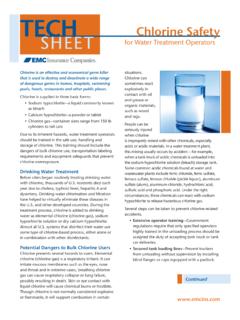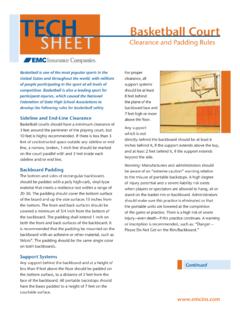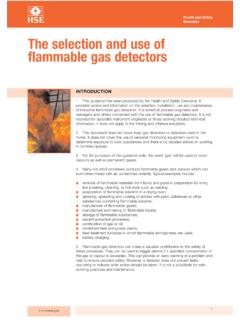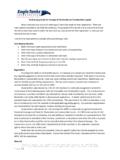Transcription of Bonding and Grounding - EMC Insurance Companies
1 AndGroundingFlammable Liquid TransferStatic electricity, or a difference in electrical potential between two objects, is most easily understood by the act of dragging one s feet while walking on a carpeted floor. If the air is dry enough, a difference in electrical potential or charge can occur. When an object with a different charge is touched, the static electricity rapidly equalizes between the two objects, creating a rapid equalization of electrical potential becomes potentially catastrophic when handling flammable liquids. Filling one container of flammable liquid from another container creates friction between the liquid and the container and can produce a static charge. Under certain conditions, a spark may ignite the flammable vapors in the area. It is for this reason that steps must be taken to equalize the difference in electrical potential between the containers. These steps are commonly referred to as Bonding and and Grounding The process of Bonding and Grounding can best be described as creating an electrical pathway between a dispensing container, a receiving container and an earth ground.
2 This pathway allows static electricity to safely dissipate into the is connecting two or more conductive objects with a conductor, such as a copper wire, which equalizes the difference in potential, or charge, between is connecting one or more conductive objects directly to the earth by means of a conductive rod driven into the ground or connection to a cold water pipe. All connections must be made to clean, bare metal. No paint, rust or other material can be allowed to interfere with the Bonding or Grounding connections, as this may add resistance to the equalization of the are two types of Bonding and Grounding connections: permanent and temporary. Permanent connections can be made using solid or braided wires and should incorporate screw-type clamps, welding or similar means of attachment. Temporary connections should use only braided wires in conjunction with spring clamps, magnetic clamps or similar methods of maintaining metal-to-metal LiquidsOSHA regulations and the Uniform Fire Code state that all Class 1 liquids (flash points below 73 F) shall not be dispensed into containers unless the nozzle and containers are electrically interconnected.
3 Some common examples of Class 1 liquids include: alcohol, toluene, acetone and benzene. The flash point of chemicals and flammable liquids can be found on the Material Safety Data Sheet (MSDS) that accompanies the product. ContinuedDisclaimer: This material is designed and intended for general information purposes only, and is not intended, nor shall be construed or relied upon, as specific legal advice. Copyright Employers Mutual Casualty Company 2014. All rights reserved. Image 2010 JupiterImages Corporation. 6134 (7-14)Home Office: 717 Mulberry St. | Des Moines, IA 50309 | 800-447-2295 | and GroundingFlammable Liquid TransferFigure 2 illustrates the Bonding and Grounding steps necessary when using a drum pump. Note that the pump is electrically connected to the bulk drum, the container being filled and the fixed Grounding system. When using reliable Bonding and Grounding techniques, static electricity should not build up during flammable liquid transfer 2. Typical Grounding system for small volume solvent dispensing via drum following NFPA illustrations show the two most common types of flammable liquid transfers.
4 Figure 1 illustrates Bonding and Grounding using the gravity feed method. The bulk drum should be connected to a Grounding system ( , a cold water pipe or a conductive rod driven into the ground), and the vessel being filled should be connected, or bonded to the bulk 1. Typical Grounding system for small volume solvent dispensing via drum tapFor Additional InformationNational Fire Protection Association: NFPA 77 Recommended Practice on Static ElectricityOccupational Safety & Health Administration: Standard 29 CFR 1910 Figures 1 and 2 are reprinted with permission from NFPA 77-2007, Recommended Practice on Static Electricity, Copyright 2006, National Fire Protection Association, Quincy, MA. This reprinted material is not the complete and official position of the NFPA on the referenced subject, which is represented only by the standard in its 1. Typical Grounding system for small volume solvent dispensing via drum tap. Figure 2 illustrates the Bonding and Grounding steps necessary when using a drum pump.
5 Note that the pump is electrically connected to the bulk drum, the container being filled, and the fixed Grounding system. When using reliable Bonding and Grounding techniques, static electricity should not build up during flammable liquid transfer operations. Figure 2. Typical Grounding system for small volume solvent dispensing via drum pump. For Additional Information National Fire Protection Association: NFPA 77 Recommended Practice on Static Electricity, 2000 Edition Occupational Safety and Health Administration: 29 CFR Figures 1 and 2 are reprinted with permission from NFPA 77-2000, Static Electricity Copyright 2000, National Fire Protection Association, Quincy, MA 02169. This reprinted material is not the complete and official position of the NFPA on the referenced subject, which is represented only by the standard in its entirety. Open Pail 2 in. x 3 in. x 3/16 in. Grounding tab Connector 1/8 in. stainless steel Grounding cable 1/4 in.
6 Stainless steel Grounding cable Building static Grounding bus For attachment to tab on building ground bus Lugs mounted on flange bolt of pump with 1/8 in. stainless steel Grounding cable and ground clamp Open pail with Grounding cable and clamp Figure 1. Typical Grounding system for small volume solvent dispensing via drum tap. Figure 2 illustrates the Bonding and Grounding steps necessary when using a drum pump. Note that the pump is electrically connected to the bulk drum, the container being filled, and the fixed Grounding system. When using reliable Bonding and Grounding techniques, static electricity should not build up during flammable liquid transfer operations. Figure 2. Typical Grounding system for small volume solvent dispensing via drum pump. For Additional Information National Fire Protection Association: NFPA 77 Recommended Practice on Static Electricity, 2000 Edition Occupational Safety and Health Administration: 29 CFR Figures 1 and 2 are reprinted with permission from NFPA 77-2000, Static Electricity Copyright 2000, National Fire Protection Association, Quincy, MA 02169.
7 This reprinted material is not the complete and official position of the NFPA on the referenced subject, which is represented only by the standard in its entirety. Open Pail 2 in. x 3 in. x 3/16 in. Grounding tab Connector 1/8 in. stainless steel Grounding cable 1/4 in. stainless steel Grounding cable Building static Grounding bus For attachment to tab on building ground bus Lugs mounted on flange bolt of pump with 1/8 in. stainless steel Grounding cable and ground clamp Open pail with Grounding cable and clamp













